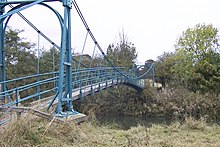Huttons Ambo
[3][5] Hutton, the toponym, derives from the Old English hōh tūn, meaning settlement on or by the hill spur.[5] Archaeological excavations in the 1950s revealed evidence of 12th- or 13th-century fortified buildings at the south end of the village of Low Hutton near the river.[6] Huttons Ambo lends its name to a specific type of Medieval pottery produced here in the 13th century consisting of large, unglazed storage jars.[7] Further excavations carried out in 2023 and 2024 by Ethos Heritage CIC uncovered a 13th-century building that may be connected with a lost manor house mentioned in village records.In addition, the excavations also identified a large Late Medieval building in the southern end of the village which seems to have been occupied until the early 18th century.

North Yorkshire2011 censusOS grid referenceLondonUnitary authorityCeremonial countyRegionYorkshire and the HumberCountryEnglandSovereign statePost townPostcode districtPoliceAmbulanceYorkshireUK ParliamentThirsk and Maltoncivil parishRyedaleMaltonDomesday BookhundredNorman invasionYork CastleHigh Sheriff of YorkSir Thomas GowerOld EnglishMedievalpotteryThirsk and Malton UK Parliament constituencySheriff HuttonNorth Yorkshire CouncilListedScarboroughRiver Derwent, YorkshireHuttons Ambo railway stationYork to Scarborough LineYork and North Midland RailwayPrimitive MethodistWesleyanListed buildings in Huttons AmboUK CensusOffice for National StatisticsButt, R. V. J.SparkfordHistoric EnglandNational Heritage List for England